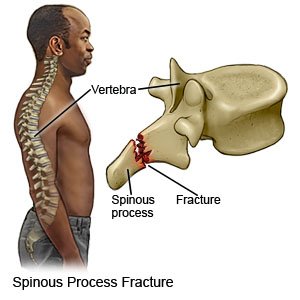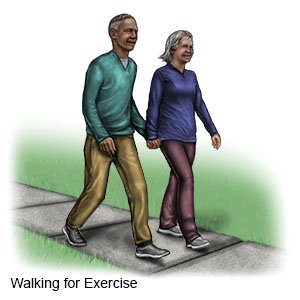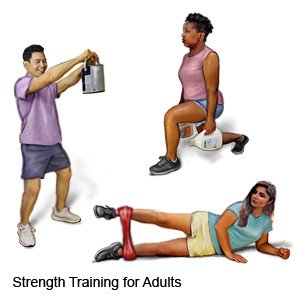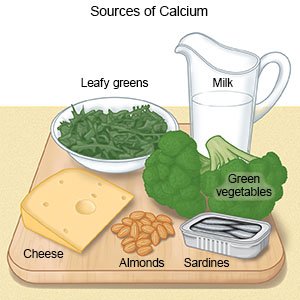Spinous Process Fracture
Medically reviewed by Drugs.com. Last updated on Aug 4, 2025.
A spinous process fracture is a break or crack in the back part of a vertebra. Your healthcare provider will give you specific instructions for home care. This depends on where the fracture happened and how severe it is.
 |
DISCHARGE INSTRUCTIONS:
Call your local emergency number (911 in the US) or have someone else call if:
- You feel lightheaded, short of breath, or have chest pain.
- You cough up blood.
- You cannot move your arms or legs.
Seek care immediately if:
- Your arm or leg feels warm, tender, and painful. It may look swollen and red.
- You have new problems urinating or having bowel movements.
- You have severe pain.
Call your doctor or orthopedist if:
- You cannot sleep or rest because of pain.
- You have pain or swelling that is getting worse or does not go away.
- You have questions or concerns about your condition or care.
Medicines:
You may need any of the following:
- Acetaminophen decreases pain and fever. It is available without a doctor's order. Ask how much to take and how often to take it. Follow directions. Read the labels of all other medicines you are using to see if they also contain acetaminophen, or ask your doctor or pharmacist. Acetaminophen can cause liver damage if not taken correctly.
- NSAIDs , such as ibuprofen, help decrease swelling, pain, and fever. This medicine is available with or without a doctor's order. NSAIDs can cause stomach bleeding or kidney problems in certain people. If you take blood thinner medicine, always ask your healthcare provider if NSAIDs are safe for you. Always read the medicine label and follow directions.
- Prescription pain medicine may be given. Ask your healthcare provider how to take this medicine safely. Some prescription pain medicines contain acetaminophen. Do not take other medicines that contain acetaminophen without talking to your healthcare provider. Too much acetaminophen may cause liver damage. Prescription pain medicine may cause constipation. Ask your healthcare provider how to prevent or treat constipation.
- Take your medicine as directed. Contact your healthcare provider if you think your medicine is not helping or if you have side effects. Tell your provider if you are allergic to any medicine. Keep a list of the medicines, vitamins, and herbs you take. Include the amounts, and when and why you take them. Bring the list or the pill bottles to follow-up visits. Carry your medicine list with you in case of an emergency.
Manage your symptoms:
The fracture may take weeks or months to heal. The following can help manage your symptoms:
- Rest as directed. Rest will help the fracture heal. Avoid activities that can cause pain or more injury. Examples include sports or shoveling heavy objects. Begin normal, slow movements as directed by your healthcare provider. Your provider will tell you when it is okay to drive and to return to your normal activities.
- Apply ice to help decrease swelling and pain. Use an ice pack, or put crushed ice in a plastic bag. Cover it with a towel before you apply it to your skin. Apply ice for 15 to 20 minutes every hour or as directed.
- Go to physical therapy, if directed. A physical therapist teaches you exercises to help improve movement and strength, and to decrease pain.
Prevent more injury:
- Strengthen your muscles and bones. Weight-bearing activities such as walking helps strengthen bones. Activities that help strengthen muscles, such as weightlifting, help protect your bones. Your healthcare provider can help you create a safe physical activity plan. He or she can also help you manage any condition that weakens your bones, such as osteoporosis.


- Shovel objects safely. Keep the shovel close to your body to lower stress on your back. Bend your knees and lift by straightening your legs. Do not lift with your arms only. Move the shovel from one hand to the other so you work different muscles. Try not to lift the shovel above your waist. Take breaks often. Stand up and straighten your spine.
- Reach or maintain a healthy weight. Extra weight puts more stress on your neck and back. Your healthcare provider can help you create a safe weight loss plan, if needed.
- Get more calcium and vitamin D, as directed. Calcium and vitamin D work together to make bones stronger. Good sources of calcium are milk, cheese, broccoli, tofu, almonds, and canned salmon or sardines. Vitamin D is in fish oils, some vegetables, and fortified milk, cereal, or bread. Vitamin D is also formed in the skin when it is exposed to the sun.

- Lower your risk for injuries or accidents. Always wear a seatbelt when you are in a car or other vehicle. Wear proper protective gear when you play sports. Keep walkways in your home clear so you will not trip as you walk. Use handrails when you go up or down stairs.
Follow up with your doctor or orthopedist as directed:
You may need to return for x-rays or other tests. Write down your questions so you remember to ask them during your visits.
© Copyright Merative 2025 Information is for End User's use only and may not be sold, redistributed or otherwise used for commercial purposes.
The above information is an educational aid only. It is not intended as medical advice for individual conditions or treatments. Talk to your doctor, nurse or pharmacist before following any medical regimen to see if it is safe and effective for you.
Further information
Always consult your healthcare provider to ensure the information displayed on this page applies to your personal circumstances.
